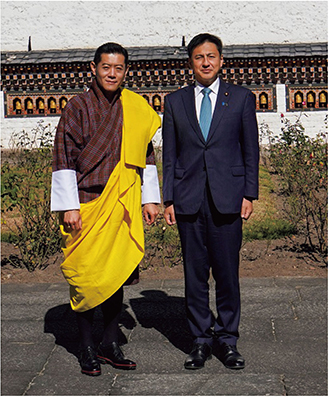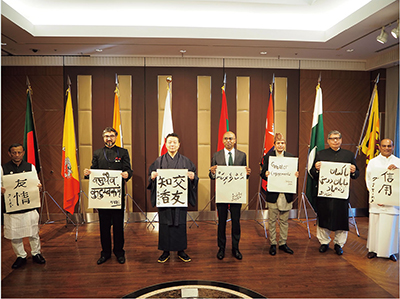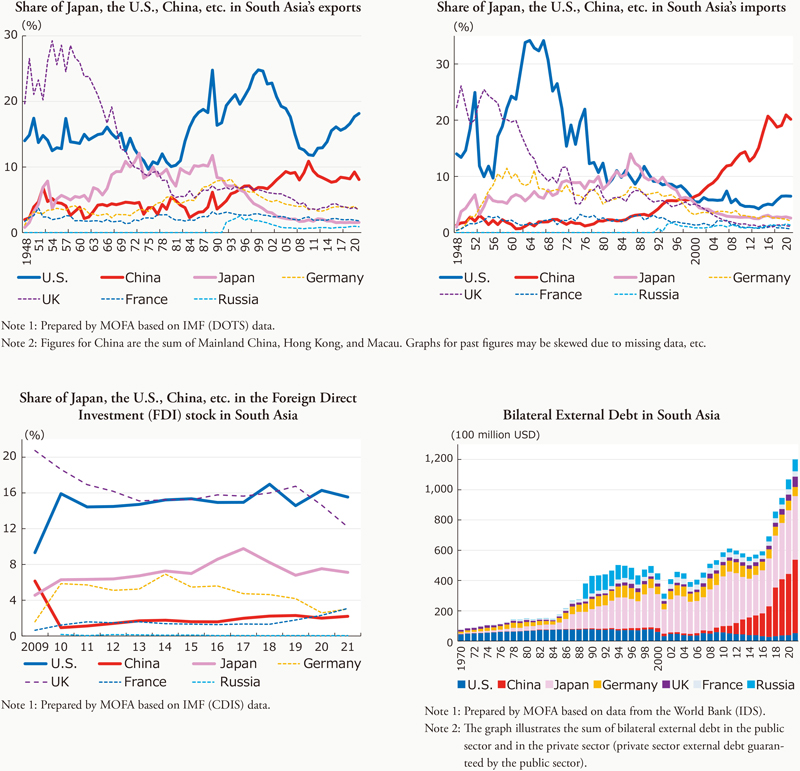Diplomatic Bluebook 2023
Chapter 2
Japan's Foreign Policy by Region
5 South Asia
(1) India27
Geopolitically, India is an extremely important country as it is positioned at the center of sea lanes in the Indian Ocean that connect Asia and Africa. Additionally, India is the third largest economy in Asia, with the world's second largest population and a huge middle-income group. In recent years, India has been implementing a variety of economic initiatives, including “Make in India,” and has been realizing steady economic growth. Although India's economy has substantially contracted due to the spread of COVID-19, it is aiming for an economic recovery through the promotion of its manufacturing industry with the new “Self-reliant India” campaign, and in 2021 real GDP recovered to pre-COVID-19 levels. In diplomatic relations, the “Act East” policy has been laid down in implementing active diplomacy to promote concrete cooperation in the Indo-Pacific region, thereby enabling India to gain more influence in the international arena as a global power.
Japan and India are the two largest democratic countries in Asia, sharing common fundamental values and principles, such as democracy and the rule of law, as well as strategic interests, and under the “Japan- India Special Strategic and Global Partnership,” have broadly deepened cooperation in their economies, security, people-to-people exchanges, etc. The Japan-India relationship is blessed with the greatest potential for development of any bilateral relationship in the world, and its importance is increasing as the uncertainty of the existing international order increases. Additionally, India is an important partner in realizing a “Free and Open Indo-Pacific (FOIP),” and multilateral cooperation, such as between Japan, Australia, India and the U.S., is steadily progressing. The deepening of bilateral and multilateral cooperation between Japan, which faces the Pacific Ocean, and India, which is located in the center of the Indian Ocean, will greatly contribute to the peace and prosperity of the Indo-Pacific region. India is also an indispensable player in building the economic order in the Indo-Pacific region, and in that sense, it is expected that India will return to the Regional Comprehensive Economic Partnership (RCEP) Agreement in the future.
2022 marks the 70th anniversary of the establishment of diplomatic relations between Japan and India, and high-level exchanges of views, including summit meetings, have continued. At the Japan-Australia-India-U.S. (Quad) Foreign Ministers' Meeting held in Australia in February, a Japan-India Foreign Ministers' Meeting was also held. In March, Prime Minister Kishida visited India as his first bilateral visit after assuming the office of Prime Minister, and at the Japan-India Summit Meeting with Prime Minister Narendra Modi, the two leaders confirmed that they would put the annual mutual visit back on track, and also reaffirmed the importance of further promoting efforts among Japan, Australia, India, and the U.S. toward the realization of FOIP. At the Japan-Australia-India-U.S. (Quad) Leaders' Meeting held in May and the Japan-India Summit Meeting held in September when Prime Minister Modi visited Japan to attend the state funeral for the late Prime Minister ABE Shinzo, the two leaders agreed to develop the Japan-India Special Strategic and Global Partnership. In September, the Second Japan-India 2+2 Foreign and Defence Ministerial Meeting and the 14th Japan-India Foreign Ministers' Strategic Dialogue were held, reaffirming that any attempts to unilaterally change the status quo by force are unacceptable, not only in the Indo-Pacific, but also in any region, and that a peaceful resolution based on international law needs to be sought. Furthermore, a number of working-level discussions have been held between Japan and India, and in June the Joint Committee Meeting on Mumbai-Ahmedabad High-Speed Railway and the Japan-India Cyber Dialogue were held.
 Second Japan-India 2+2 Foreign and Defence Ministerial Meeting (September 8, Tokyo)
Second Japan-India 2+2 Foreign and Defence Ministerial Meeting (September 8, Tokyo)- 27 Ministry of Foreign Affairs website detailing Prime Minister Kishida's visit to India in March 2023:
https://www.mofa.go.jp/s_sa/sw/in/page1e_000582.html
(2) Pakistan
Pakistan is situated in a strategic location connecting Asia and the Middle East, and its political stability and economic development are essential for the stability and growth of the region. The country has a population of more than 200 million, and approximately 65% of the total population is under 30 years old, thus making its economic potential high. In 2022, heavy rains from mid-June to September caused flood damage in the province of Sindh and other parts of Pakistan, resulting in enormous human and property damage. It was also a major blow to the economy, which was on a recovery trend.
In foreign relations, the India-Pakistan relationship has remained tense since August 2019 when the Government of India decided to revoke Article 370 of the Constitution, which recognized the special status of Jammu and Kashmir. Under the “All Weather Strategic Cooperative Partnership,” Pakistan's relationship with China has been enhanced in a wide range of fields toward the construction of an economic corridor between China and Pakistan (CPEC), which is an important constituent element of China's “Belt and Road” initiative. In domestic affairs, Prime Minister Imran Khan resigned in April due to the passage of a no-confidence motion in Parliament, and Prime Minister Shehbaz Sharif was newly appointed after a nomination election.
In 2022, Japan and Pakistan celebrated the 70th anniversary of the establishment of diplomatic relations, and in April, Prime Minister Kishida and Prime Minister Sharif sent congratulatory messages. In August, Parliamentary Vice-Minister for Foreign Affairs HONDA Taro visited Pakistan, and a Japan-Pakistan Foreign Ministers' Meeting was held between Foreign Minister Hayashi and Foreign Minister Bilawal Bhutto Zardari at the ASEAN-related Foreign Ministers' Meetings. In September, Prime Minister Kishida held a Japan-Pakistan Summit Meeting with Prime Minister Sharif at the UN General Assembly, and the two leaders concurred to further strengthen bilateral relations. A Government Business Joint Dialogue was also held in September, and there was an exchange of views on ways to promote bilateral trade and to improve the investment environment.
In addition to the grant aid that Japan has so far provided to Pakistan in the fields of health, water and sanitation, and disaster prevention, etc., as a measure to address the flood disaster, Japan also provided tents and plastic sheets as emergency relief supplies, as well as deciding on and extending emergency grant aid of 7 million US dollars through international organizations. In light of the worsening humanitarian and security situation caused by the flood disaster, Japan provided emergency assistance of approximately 38.98 million US dollars in the areas of health and medical care, water and sanitation, food and nutrition, and seeds and fertilizers through contributions to international organizations such as the World Health Organization (WHO), the United Nations Children's Fund (UNICEF), the United Nations World Food Programme (WFP), and the Food and Agriculture Organization of the United Nations (FAO), etc., in order to ensure stability in the country. Furthermore, in January 2023, Parliamentary Vice-Minister for Foreign Affairs AKIMOTO Masatoshi attended the International Conference on Climate Resilient Pakistan that was held in Geneva, and announced that, subject to domestic procedures, Japan would continue to provide approximately 77 million US dollars in additional assistance in 2023 and beyond, including in the areas of disaster prevention, health and medical care, and agriculture.
(3) Bangladesh
Bangladesh, in which Muslims account for around 90% of the population, is a democratic country located in the Bay of Bengal and is geopolitically very important as an intersection between India and ASEAN. In terms of diplomacy, with the deterioration in peace and order in Rakhine State of Myanmar since August 2017, more than 700,000 displaced persons have flooded into Bangladesh (as of the end of December 2022), but their return has not yet been realized. There are concerns that their prolonged displacement will put a growing burden on the host community and that local peace and order will deteriorate. On the economic front, Bangladesh has been steadily growing, and in 2021, achieved an economic growth rate of 6.9%. With a population of around 166 million people, Bangladesh has a production base with abundant high-quality labor, and the high potential of its market from considerable infrastructure demand is attracting attention. The number of Japanese affiliated companies developing business in the country has increased from 61 in 2005 to 324 in 2021. However, the securing of a stable supply of electric power as well as infrastructure improvement remain as challenges for foreign companies investing in the country.
In 2022, Japan and Bangladesh celebrated the 50th anniversary of the establishment of diplomatic relations, and in February Prime Minister Kishida and Prime Minister Sheikh Hasina sent congratulatory video messages. Foreign Minister Abdul Momen visited Japan in April and September and held Japan-Bangladesh Foreign Ministers' Meetings with Foreign Minister Hayashi, and during his visit in September, he attended the state funeral for the late Prime Minister ABE Shinzo. Parliamentary Vice-Minister for Foreign Affairs Honda visited Bangladesh in July, and State Minister for Foreign Affairs TAKEI Shunsuke visited Bangladesh in November.
(4) Sri Lanka
Sri Lanka is situated in a strategic location on the sea lanes in the Indian Ocean. The country is traditionally a friendly country to Japan and its geopolitical and economic importance is note-worthy. With regard to domestic politics, domestic and external debt increased due to major policy changes, including large-scale tax cuts from 2019 and the stagnation of the domestic economy due to the spread of COVID-19. The economic crisis, including shortages of fuel, food, and medicine, along with prolonged power outages and record inflation caused by a severe shortage of foreign currency against the backdrop of deficits in the international balance of payments and the budget balance, has led to a public outcry, and since March there have been frequent demonstrations demanding the resignation of President Gotabaya Rajapaksa. On July 9, there were large-scale protests demanding the President's resignation, and in response to some of the protestors who occupied the presidential palace, the presidential office, and the prime minister's office, President Gotabaya Rajapaksa fled the country on July 13 and resigned on July 14. Prime Minister Ranil Wickremesinghe was then inaugurated as the new President on July 21.
On April 12, Sri Lanka's Ministry of Finance announced measures to temporarily suspend payments on its external debt pending a debt restructuring in line with the International Monetary Fund's (IMF) economic adjustment program. On May 18, the grace period for interest payments on 78 million US dollars' worth of long-term foreign currency denominated government bonds expired, triggering the country's first sovereign debt default. As a result of discussions with the IMF, the Government of Sri Lanka reached a staff-level agreement on September 1 for an Extended Credit Facility (EFF) worth 2.9 billion US dollars for a 48-month period. In addition to measures to address the country's current inflation and to secure essential goods, efforts are being made toward the approval of the IMF Executive Board for the agreement, including revenue and expenditure reform, formulation of the 2023 budget, state-owned enterprise reforms, and debt restructuring. With a negative economic growth of 8% to 9% expected in 2022, the country is working to restore economic stability and sustainability through a series of policy reviews.
In response to the deteriorating humanitarian situation in Sri Lanka due to the economic crisis, Japan, in cooperation with international organizations, has provided a total of 22.7 million US dollars in grant assistance, including 6.5 million US dollars in humanitarian aid to provide medicines and food to the country.
Japan and Sri Lanka celebrated the 70th anniversary of the establishment of diplomatic relations in 2022, and related events were held in both countries. In August, Foreign Minister Hayashi and Foreign Minister Ali Sabry held a Japan-Sri Lanka Foreign Ministers' Meeting at the ASEAN-related Foreign Ministers' Meetings; in September, when President Wickremesinghe visited Japan to attend the state funeral for the late Prime Minister ABE Shinzo, Prime Minister Kishida and President Wickremesinghe held a Japan-Sri Lanka Summit Meeting and Foreign Minister Hayashi paid a courtesy call to President Wickremesinghe; and in October, Foreign Minister Hayashi and Foreign Minister Sabry had a Foreign Ministers' telephone call.
(5) Nepal
Nepal has geopolitical importance as an inland state in South Asia between the great powers of China and India. In domestic affairs, Prime Minister Pushpa Kamal Dahal was newly appointed in December following the results of federal elections in November for the House of Representatives.
For many years, Japan has been a major donor to Nepal and the two countries have traditionally built friendly relations through people-to-people exchanges such as mountaineering.
Japan has continued to support Nepal, where transition from a monarchy to a federal democracy took place in 2008, for the consolidation of democratization and the strengthening of governance, by dispatching experts to assist in the improvement of legal system and capacity of the media sector, among others. In November, an election observer team headed by State Minister for Foreign Affairs Takei visited Nepal and inspected polling and vote counting stations for the House of Representatives election, confirmed that the elections were being held in a free, transparent, and fair manner, interviewed election managers on the operational status of polling and vote counting stations and future improvements, and met with the electoral commissioner.
In 2022, Japan and Nepal celebrated the 120th anniversary of student exchanges, and events were held in both countries.
(6) Bhutan
Bhutan sets Gross National Happiness (GNH) as a guideline of the administration and is working on the priority issues of reducing poverty, improving the quality of healthcare and education, gender equality, the preservation of the environment, culture and traditions, stabilization of the macroeconomy, etc., under the 12th Five-Year Plan (from July 2018 until June 2023).
Bhutan has traditionally been friendly toward Japan, and there is a rich history of exchanges between the Japanese Imperial and Bhutanese Royal families. In September, Princess Ashi Euphelma Choden Wangchuck visited Japan to attend the state funeral for the late Prime Minister ABE Shinzo and met with Prime Minister Kishida. Prime Minister Kishida expressed his intention to continue to strengthen bilateral relations including in the agricultural sector. State Minister for Foreign Affairs Takei also visited Bhutan in November.
 State Minister for Foreign Affairs Takei paying a courtesy call to Princess Wangchuck of Bhutan (November 22, Thimphu, Bhutan)
State Minister for Foreign Affairs Takei paying a courtesy call to Princess Wangchuck of Bhutan (November 22, Thimphu, Bhutan)(7) The Maldives
Situated in a strategically important location in the Indian Ocean, the Maldives is an important partner to Japan in realizing a “Free and Open Indo-Pacific (FOIP).” Economic growth in the Maldives is mainly led by fishery and tourism, which account for about 30% of its GDP, and the country's per-capita GDP has reached the highest level in South Asia region. The Maldives' tourism industry was hit hard by the spread of COVID-19, but the number of tourists is currently returning to pre-COVID-19 levels, led by the recovery of those from Western countries (as of December 2022). Since his inauguration, President Solih has been promoting a foreign policy of strengthening cooperation with every country that hopes to build mutually beneficial relations, and of advancing cooperation with other countries in the region including India.
2022 was the 55th anniversary of the establishment of diplomatic relations between Japan and the Maldives, and Foreign Minister Hayashi and Foreign Minister Abdulla Shahid sent congratulatory messages in November. In May, Parliamentary Vice-Minister for Foreign Affairs MIYAKE Shingo attended the 78th General Assembly of the UN Economic and Social Commission for Asia and the Pacific (ESCAP) and met with Foreign Minister Shahid. In September, in addition to a Foreign Ministers' telephone call between Foreign Minister Hayashi and Foreign Minister Shahid, a Japan-Maldives Foreign Ministers' Meeting was held when Foreign Minister Shahid came to Japan to attend the state funeral for the late Prime Minister ABE Shinzo, and the two Ministers agreed to cooperate even more closely toward the realization of FOIP. State Minister for Foreign Affairs Takei also visited the Maldives in December.
What do you think of when you hear the words “Southwest Asia”? Is it curry? Curry is, of course, the region's signature dish, but it is by no means the only one. The seven countries of Southwest Asia – Bangladesh, Bhutan, India, the Maldives, Nepal, Pakistan, and Sri Lanka – are rich in individuality and blessed with ancient civilizations, abundant nature and rich cultures. But did you also know that they have long and deep relationships with Japan?
The countries of Southwest Asia have great affinity toward Japan and have long built friendly relations with Japan. In 2022, Japan celebrated commemorative milestones(Note) with each of these countries and, in order to further deepen exchanges with the region, Japan designated 2022 as “Japan-Southwest Asia Exchange Year” and held a variety of related events in Japan and throughout Southwest Asia.
 Ambassadors to Japan and other representatives of each country showing their thoughts in calligraphy at the “Kakizome Party” kickoff event for the Exchange Year (January 27, Tokyo)
Ambassadors to Japan and other representatives of each country showing their thoughts in calligraphy at the “Kakizome Party” kickoff event for the Exchange Year (January 27, Tokyo) Exchange Year banner set up on the main road at the Shimokitazawa Curry Festival (October, Tokyo)
Exchange Year banner set up on the main road at the Shimokitazawa Curry Festival (October, Tokyo) The official logo for “Japan-Southwest Asia Exchange Year 2022”
The official logo for “Japan-Southwest Asia Exchange Year 2022”This logo, illustrated with origami pigeons, symbols of peace and friendship, expresses hope for the further development of friendly ties between Japan and the Southwest Asian countries.
At the kickoff event held in January, Parliamentary Vice-Minister for Foreign Affairs HONDA Taro invited the Ambassadors of Southwest Asian countries to Japan, as well as other participants, for a “Kakizome Party” (kakizome is a traditional event in Japan when people write calligraphy for the first time at the beginning of a new year). The participants expressed their hopes and wishes for the Exchange Year by writing New Year's calligraphy to celebrate the beginning of the Japan-Southwest Asia Exchange Year and to wish for the further deepening of friendly relations between Japan and each country. Parliamentary Vice-Minister for Foreign Affairs Honda wrote “交友知香” (“Ko Yu Chi Ka” in kanji characters) and expressed his wish for the deepening of friendship amid the rich mellow spice aroma of the Southwest Asian countries and the traditional Japanese ink aroma hanging in the air while writing calligraphy.
In October, MOFA participated in one of the largest curry festivals in Japan, held in Shimokitazawa, Tokyo, in order to promote exchanges between Japan and Southwest Asian countries through curry, a food culture that is common to both Japan and Southwest Asia.
Additionally, during this Exchange Year, a variety of organizations in Japan and Southwest Asian countries applied for their events to be endorsed as commemorative events, and the official logo was used to make the anniversary year even more exciting.
Furthermore, “an official of MOFA, MINAMI Asiako” @southasiako2022, an official Twitter account of MOFA, provided updates on events held by Japanese embassies in Southwest Asian countries, interesting information about Southwest Asia, and stories from officials of MOFA that are involved with the region to bring Southwest Asia closer to many people. These posts helped to familiarize about 3,000 followers with Southwest Asia.
The long-standing bonds between Japan and Southwest Asia, which have continued from time immemorial to the present, were further deepened through the Japan-Southwest Asia Exchange Year 2022 and have begun to take their next step into the future as steadfast partners.
- Note: Anniversaries between Japan and Southwest Asian countries in 2022
・50th Anniversary of the Establishment of Diplomatic Relations between Japan and Bangladesh
・35th Anniversary of the conclusion of the JOCV Agreement between Japan and Bhutan
・70th Anniversary of the Establishment of Diplomatic Relations between Japan and India
・55th Anniversary of the Establishment of Diplomatic Relations between Japan and the Maldives
・120th Anniversary of International Student Exchanges between Japan and Nepal
・70th Anniversary of the Establishment of Diplomatic Relations between Japan and Pakistan
・70th Anniversary of the Establishment of Diplomatic Relations between Japan and Sri Lanka
Trade: In recent years, the U.S. has become the top destination for the region's exports. The U.S.'s share had been declining since around 2000, but in the 2010s exports from India increased and the U.S.'s share as an export destination began rising again. In terms of imports, China's share of the region's import has increased in recent years. In 2021, Japan ranked 19th in terms of its share in the region's exports and was 11th in terms of imports.2
Investment: The FDI to India alone accounts for approximately 90% of the total inward FDI stock in the region. The U.S. and the U.K. make up a large portion through large investment in India, and Japan also has a certain share. Mauritius is the top investor in India. China has a strong investment presence in Pakistan, Sri Lanka, and Nepal, while India, a regional power, has heavily invested in Nepal and Bhutan.
Finance: In the 2010s, Pakistan, Bangladesh, and Sri Lanka increased their debt to China, making China the largest bilateral creditor country as of 2021. Japan ranks second after China.

- 1. See page 193 for notes regarding this data.
- 2. While only a limited number of countries such as Japan, the U.S., and China are illustrated in the chart the rankings in the text are the rankings for all countries/regions for which data is available (including the countries, etc., in the relevant region).

